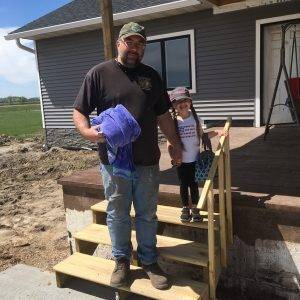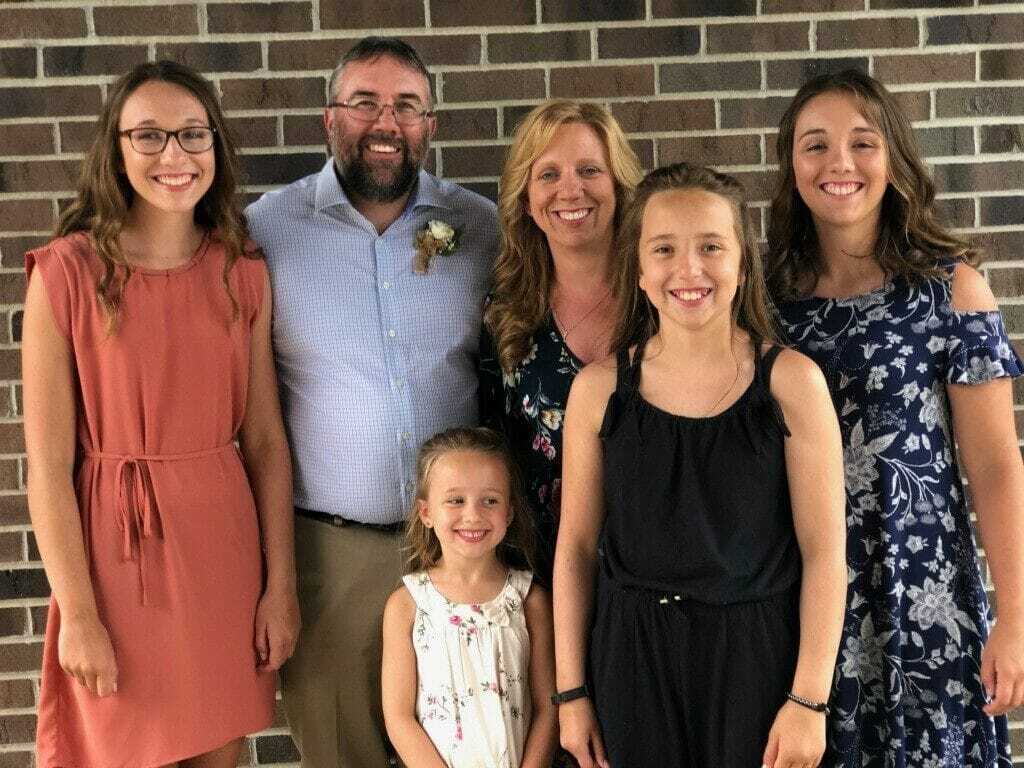Pork Project Teaches Teens Checks and Balances
That’s the lesson Craig and Julie Nice are teaching their four children on their farm in Ardoch, North Dakota. Their oldest two daughters, Alexis and Elizabeth, have learned to balance a checkbook and repay a loan thanks to their pork enterprise.
“When I was young, my family always raised a few head of hogs to put some pork in our freezer and then sell to the neighbors,” said Craig. “Julie and I talked about it. We decided it would be a good way to teach our kids responsibility and a lot of really great life lessons.”
In 2016, the Nice’s oldest daughters bought 25 feeder pigs. The girls oversold their product. Realizing there was a market for locally raised pigs, Alexis and Elizabeth wanted to expand their operation but needed capital. The FSA officer suggested to Craig that Alexis and Elizabeth should complete a Youth Loan Application. The girls wrote a business plan, which included developing a budget. They had to list everything they would need to grow their business: fencing, additional barn space, feeders, feed grinder and livestock trailer.
Like most start-up businesses, profit during the first several years was put back into the business to fund its growth. This year, or Year 4 of the business, is the first time the girls are projected to put money in their individual bank accounts.
 In addition to money management, the girls have learned other important skills like risk management and genetic diversification. Three years ago, the girls bought 50 feeder pigs from one producer. Because that group of pigs had several problems, the following year Alexis and Elizabeth purchased 25 pigs from two different farms. Last year the Nice sisters bought groups of feeder pigs from three different farms.
In addition to money management, the girls have learned other important skills like risk management and genetic diversification. Three years ago, the girls bought 50 feeder pigs from one producer. Because that group of pigs had several problems, the following year Alexis and Elizabeth purchased 25 pigs from two different farms. Last year the Nice sisters bought groups of feeder pigs from three different farms.
“It’s just like planting seed,” says Craig, who is a Latham® seed dealer. “Farmers plant more than one corn hybrid to spread risk with different genetics. Our girls have learned it’s important to diversify risk.”
As the sisters’ business grew, they realized they needed to name it. They started with the word “prairie” because the family’s yard started as prairie. Their farmyard was a CRP field in 2013. As Craig’s seed business expanded, he needed a yard to build a shed to store seed. They built the seed shed/shop first. Then in 2015 they started building their house.
Little Farm on the Prairie was chosen for the girls’ pork venture. The next step was finding a processor who could work with them. They deliver live pigs in groups of seven to 13 for processing. This allows the local processor to handle the volume, plus it allows the girls to market them in smaller groups.
The girls market their pork primarily through word of mouth. They also hang posters in local businesses and promote it through their Little Farm on the Prairie Facebook page.
Business planning, financial management, risk management and marketing are life skills that are important regardless of what careers these young women will decide to pursue. Alexis, 19, is a sophomore at Mayville State University, where she is a student manager of the Comets women’s basketball team. She is working on a degree in exercise science and plans to continue her education in to become an athletic trainer. After she graduates from college, Alexis would like to return home. The family’s farming enterprise includes a custom fertilizer application and custom planting, a seed dealership, and a repair shop for farm equipment as Craig was a JD service technician for 10 years. He also sells air drill parts and rebuilds air drills.
One of the reasons Craig became a Latham dealer is because the 2018 Latham Seed Product Guide contained an article that encouraged the next generation to come into the farm. Farming is a legacy for both Craig and Julie’s family. In fact, Alexis was one week old when she had her first combine ride.
Life is interesting on the Nice family farm as each of their four daughters has very different interests. Elizabeth, 15 years old, is a sophomore in high school. She has a love for children, so Elizabeth spends most of her summer babysitting for a local family. Her parents describe her as having a gentle, kind, loving personality. Elizabeth is very active. She’s a leader in her school and loves playing volleyball.
Emma, 11 years old, is a sixth grader. Her parents call her their inventor. Craig has to hide the duct tape or it’s gone. Emma made a wallet out of Gorilla tape, complete with a pouch for credit cards. She enjoys playing cops and made her own holster out of duct tape. She also enjoys participating robotics and playing basketball in school.
Five-year-old Josephine is a kindergartener. She loves to watch cooking shows. A fan of Molly Yeh from the television series Girl Meets Farm, Josephine often asks her parents to drive through East Grand Forks “to see if Molly is home.” East Grand Forks is a short 30-minute drive from the Nice family farm, but Molly is anything but the girl next door.
Yeh grew up in the Chicago suburbs with a Chinese father and Jewish mother. She studied percussion at Juilliard in New York City. After getting married, Yeh relocated with her husband to a sugar beet farm in East Grand Forks. There she has managed to build a culinary empire, including the award-winning cookbook, “Molly on the Range.” She is the creator of the critically-acclaimed and highly popular food and lifestyle brand “my name is yeh”, which has been recognized by the likes of the New York Times and Food & Wine. She was named “blog of the year” by New York Magazine, Saveur, and “food blog of the year” by Yahoo. Yeh in 2017 made Forbes’ “30 Under 30” list.
Inspired by cooking shows and their Norwegian heritage, last year the Nice family decided to carry on a family tradition of making lefse. Julie texted Craig’s cousin for the recipe. Together Craig and Julie watched a “how to” video on YouTube. After all, they watched a YouTube video to learn how to side their house themselves. Why not learn how to make lefse the same way?
“We had so much fun, and our lefse turned out so well,” says Julie. “Lefse is something we will continue to make during the holiday season,” says Julie. “We freeze the lefse in packages of six since there are six of us in the family. When we want a treat, we just pull a bag from the freezer. Our favorite way to top them is just butter and sugar.”
Today the Nice family is sharing their time-honored tradition of lefse making with us.
Lefse Recipe
Ingredients
8 cups riced potatoes (approx. 5 pounds)
¾ cup whipping cream
½ cup sugar
1 tbs salt
3½ cups all purpose flour
1 stick margarine (country crock 60% veg oil)
Instructions
- Cook potatoes and rice.
- In saucepan, add salt, sugar, cream and margarine. Bring to a boil.
- Add potatoes and cool overnight.
- In the morning, split dough in half. Then add 1 cup of flour to each half and mix well.
- Next roll dough into 2-inch balls and return it to the fridge to cool for a few hours.
- Then roll balls out thin, using remaining flour for rolling.
- Fold in quarters when cooked and keep covered.
- Use 500 degrees on griddle.
COOK’S TIP: We only take a few dough balls out of the fridge at a time. Keeping the ball cool is key to getting it to roll out nicely

